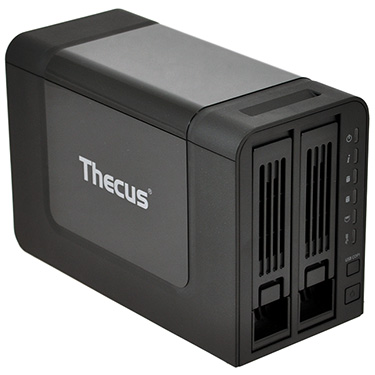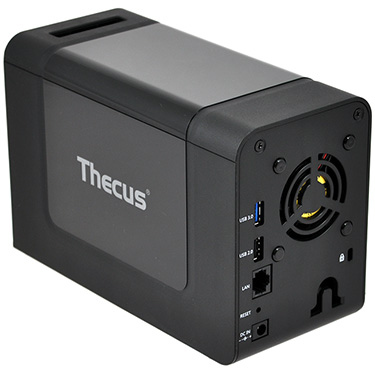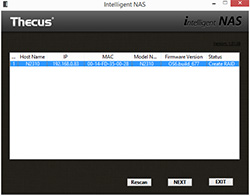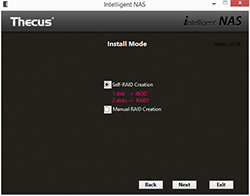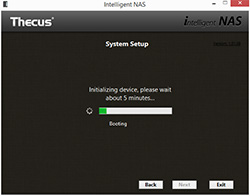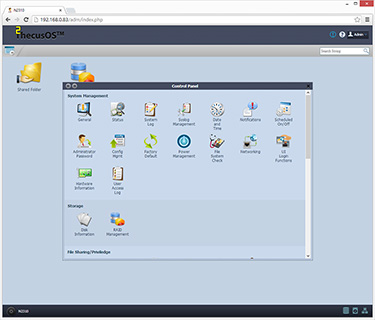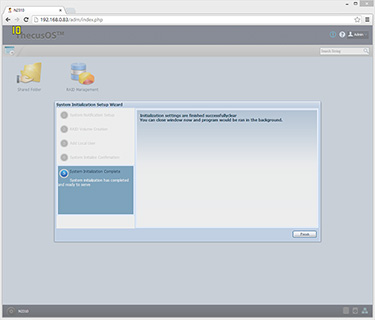Introduction
What will it take for mainstream audiences to adopt network-attached storage servers within the home? We've seen manufacturers attempt to lure consumers with various strategies in recent months - ranging from simple, single-drive solutions to fanless units aimed at the living room - but maybe the answer is more obvious: NAS servers need to be more affordable.
Proposing that price really is key, Thecus is hoping to strike the right notes with the newly released dual-bay N2310. Launched with an MSRP or £120 - almost half the price of the existing N2560 - the N2310 touts "best-in-class value" and is aimed squarely at individuals or small offices looking for simplicity and capable performance from a well-known brand.
It's an area of the market that's becoming increasingly competitive, and Thecus is up against stern competition from the likes of Buffalo's LinkStation 421DE (£85) and Shuttle's Omninas KD20 (£120), to name but a few.
Served in a compact 135mm x 97mm x 207mm body, the N2310 is a neat little box that, as expected, is made primarily from plastic. Build quality isn't up to the standards of premium NAS models, but the N2310 feels sturdy enough and the dual pull-out drive bays work well. They, too, are plastic (save for the metal spring) and support your choice of 2.5 or 3.5in SATA II drive.
We're a little surprised to see Thecus opt to maintain easily accessible drive bays - it's a handy feature for pro users, but it can leave the N2310 vulnerable to unwanted access. In a home NAS, concealed drive bays that are out of reach of kids may be preferable.
Elsewhere, the front of the box is lined with a series of status LEDs - power, status, HDD1, HDD2, LAN and USB - along with a dedicated USB copy button and a power on/off switch. Around back, the single exhaust fan is joined by USB 3.0, USB 2.0, Gigabit Ethernet, a reset button and a connector for the small external power supply. Everything we'd expect to find on an entry-level NAS is present and accounted for, but it's a shame Thecus didn't route one of the USB ports to the front for easier access.
HDMI output hasn't made the cut, as the N2310 isn't geared for direct multimedia playback and is designed principally as a network server that, among other things, can stream high-def content to attached devices. Providing the power to make it happen is single-core Applied Micro Catalina APM86491 processor clocked at 800MHz, along with 512MB of DDR3 memory.
The single-core PowerPC processor doesn't sound particularly spectacular, yet Thecus has managed to eke out a respectable amount of performance from the low-power chip. We'll get on to benchmark numbers shortly, but first let's take a quick look at the software side of things.
As is the case with most modern-day NAS solutions, setup is simple and straightforward. After installing your drives (remember, the £120 N2310 is a drive-less unit), it's merely a case of attaching the server to your network via the provided patch cable, hooking up the power supply, switching it on and pointing any networked web browser to install.thecus.com.
From here, the user is able to download a small Intelligent NAS utility that detects the server and begins setup. Everything worked without a hitch during our own tests, and in under five minutes the N2310 was up and running. Once initial setup is complete, the user is directed to a web-based admin panel that should look and feel familiar to anyone who has used a Thecus product in recent years.
The latest release, ThecusOS 6, has been covered in an earlier review and a live demo is available for your perusal at Thecus.com.
In a nutshell, Thecus' software offers a reasonable feature set but can at times be lacking in refinement. It regularly feels as though too many clicks are required to get to simple settings, and the initial setup doesn't do much beyond creating a RAID array. We'd like to see the setup wizard create user accounts, automatically set date and time, and provide shortcuts for mapping shared folders. Doing so would make the NAS more accessible to less experienced users.
With the focus on SOHO use, the N2310 offers support for RAID 0 and 1, built in iTunes, print and FTP servers, a dedicated BitTorrent client, scheduled on/off, multiple backup facilities, companion apps for iOS and Android, as well as Plex Media Server integration. There's no iSCSI support, however the N2310 covers most bases for an entry-level NAS; the one obvious omission is that it doesn't currently support idle spin-down, meaning hard disks can't automatically enter standby after a period of inactivity.
Thecus has, we feel, fallen behind the likes of Qnap and Synology in terms of software implementation, however while ThecusOS 6 isn't as sleek or user-friendly as some of the competition, it's a utilitarian piece of software that, with a bit of patience, ultimately gets the job done.






